Indian Blackbird

Indian BlackbirdTurdusmerulasimillimus
Etymology:
- Turdus : Latin word for Thrush
- Merula: Latin for Blackbird
- Simillimus: Latin word for “Very similar”
Vernacular Names: Mar: Kala Kastur
Distribution in India: Resident of hillsof Peninsular India.
iHimalays
Description:
Size of 19–22 cm; wt. of 60–94 g. The male of nominate race is dark grey-brown above, darkest on crown with slight capped appearance, slightly paler greyish-brown below, palest on throat and mid-belly, with orange-yellow bill, eyering and legs. Thefemale is paler overall, throat slightly streaked. The juvenile is like female above, but with orangey-buff tips of wing-coverts, orangey-buff with dark brown scaling and mottling below. The race nigropileus is paler than nominate, male with blackish head and paler grey-brown collar, lower underparts are paler. In racebourdillonithe male is uniform slate-brown with paler edges of primaries; race kinnisii is smallest, greyish-slate with vague bluish tinge and dark-scaled upperparts, female is similar but rather duller.
Habitat:
It breeds in moist deciduous and evergreen broadleaf forest, sholas, wooded ravines, dense scrub-jungle, scrubby woodland edge, groves, copses, shade coffee plantations, in hills above 900 m. In winters it comes down to plains, in similar habitat and also wooded gardens and plantations
Food Habits:
It eatsInvertebrates and fruits of forest. It forages on ground, and pecks at dung beside forest track. It feeds in fruiting and flowering trees.
Breeding Habits:
They breed inFeb–Nov in India; Mar–Apr and Aug–Sept in Sri Lanka. The nest is a deep bulky cup of grass, moss and roots, strengthened with a few twigs and a mud layer, and with inner lining of fine roots, placed in tree fork, stump or bush. They lay a clutch of 3-4 eggs